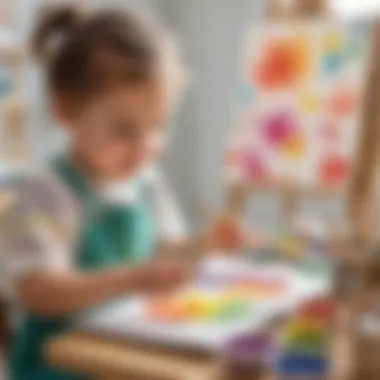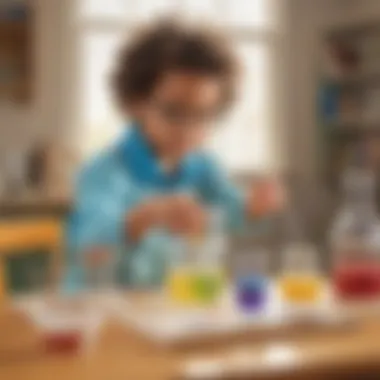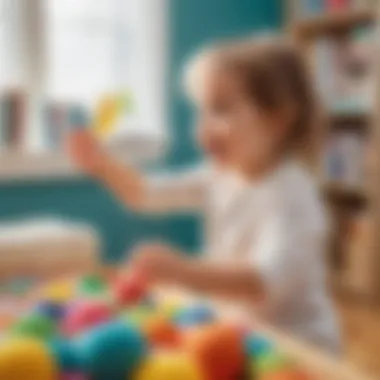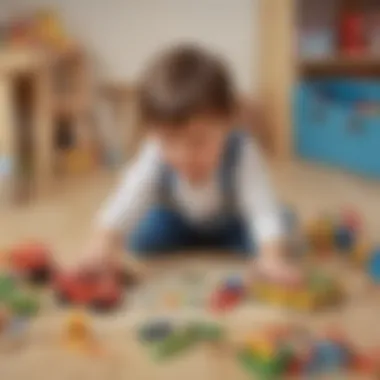Engage Your Preschooler with Exciting and Educational Home Activities


Science Fun Facts
Science can be a fascinating subject for young minds, filled with interesting trivia and quirky anecdotes that make learning engaging. Did you know that the smallest bone in the human body is located in the ear? Imagine that! Such fun facts can captivate preschoolers and ignite their curiosity about the world around them. Stories of scientific discoveries and records can inspire a sense of wonder and exploration in children, leading them to ask thought-provoking questions about how things work. Encouraging their inquisitive nature through science fun facts sets the stage for a lifelong passion for learning.
Discover the Wonders of Science
Preschoolers can embark on a thrilling journey to uncover the marvels of science right at home. Through interactive learning tools and educational videos, children can explore various scientific concepts in a hands-on and exciting way. These tools not only make learning fun but also encourage critical thinking and problem-solving skills. By showcasing real-life applications of science, such as how plants grow or why the sky changes color, preschoolers can easily connect the dots between what they learn and the world they observe every day.
Science Quiz Time
Engaging preschoolers in science quizzes can be a playful and effective way to reinforce their learning. Interactive quizzes, multiple-choice questions, brain teasers, and puzzles can pique children's curiosity and test their understanding of scientific concepts. By incorporating elements of gamification, such as rewarding correct answers with virtual badges or points, learning becomes an enjoyable challenge for young learners. Science quiz time not only assesses knowledge but also nurtures a competitive spirit and a thirst for knowledge in preschoolers.
Science Experiment Showcase
Introducing preschoolers to simple and safe science experiments can spark their interest in hands-on learning. Fun and engaging experiments, accompanied by step-by-step instructions and a materials list, empower children to explore scientific principles in a practical way. Incorporating safety tips and precautions ensures that learning remains a secure and enjoyable experience. From making mini volcanoes with baking soda and vinegar to creating rainbow reflections with a glass of water, the science experiment showcase ignites a sense of wonder and discovery in young minds.
Introduction
Engaging preschoolers in stimulating activities at home transcends mere pastime engagements; it fosters a fertile ground for exploration, experimentation, and skill development. The essence lies in providing a safe and nurturing space that encourages children to embrace their innate curiosity, creativity, and desire to learn. Through carefully curated activities, children can enhance their cognitive functions, fine motor skills, communication abilities, and emotional intelligence. It's a journey of discovery and growth where every moment spent engaging in these activities contributes to the child's overall development.
Moreover, the significance of these engaging activities extends beyond immediate skill-building to instilling foundational values such as patience, perseverance, and collaboration. By immersing preschoolers in a diverse range of activities that cater to their interests and capabilities, caregivers lay the groundwork for inculcating essential life skills early on. These activities serve as building blocks for future academic success, critical thinking, and problem-solving skills, laying a robust foundation for lifelong learning.
Educational Activities
Education is an essential component in a child's developmental journey, especially for preschoolers. These early years are crucial for laying a strong foundation for future learning. The Educational Activities included in this article aim to stimulate young minds and foster a love for learning. By engaging in these activities, children can enhance their cognitive skills, language development, and spark curiosity about the world around them. Providing a mix of playful and structured learning opportunities, these activities encourage children to explore, experiment, and problem-solve, all of which are key skills for their future academic success. These activities serve as an effective way to introduce children to basic scientific principles, mathematical concepts, language recognition, and cognitive development. By incorporating Educational Activities into everyday routines, parents and caregivers can support their child's growth and intellectual curiosity.
Simple Science Experiments
When it comes to Simple Science Experiments, preschoolers have the opportunity to engage in hands-on learning that captures their imagination. Color Mixing Exploration is a popular experiment that introduces children to the concept of blending colors and understanding color theory. Through this activity, children can observe how primary colors combine to form secondary colors, promoting their artistic and scientific skills. While some children may find it messy, the joy of discovery outweighs any minor setbacks. Sink or Float Experiment is another intriguing activity where children can predict and test whether various objects will sink or float in water. This experiment not only teaches basic physics principles but also encourages critical thinking and problem-solving. Lastly, Shadow Tracing allows children to explore the concept of shadows and light, fostering creativity and spatial awareness. While occasionally mistakes might deviate the results slightly, the overall learning experience remains valuable and captivating, enhancing the young minds' understanding of the physical world.


Alphabet and Number Games
Alphabet and Number Games serve as fundamental building blocks for language and mathematical development in preschoolers. Letter Scavenger Hunt is a playful way to reinforce letter recognition and phonics skills. Children can actively engage in searching for letters within their environment, making learning an interactive and enjoyable experience. Counting with Household Items offers a practical approach to introducing mathematical concepts by incorporating everyday objects into counting activities. This hands-on method helps children grasp numerical concepts more effectively while also enhancing their fine motor skills. Number Bingo adds a fun twist to number recognition and basic arithmetic. By associating numbers with a game format, children can develop numerical fluency in an entertaining manner. Although occasional misunderstanding may arise, the overall educational benefit of these games far outweighs any temporary confusion.
Nature Walk and Outdoor Exploration
Engaging in Nature Walk and Outdoor Exploration activities enables preschoolers to connect with the natural world and appreciate its beauty. Treasure Hunt encourages children to explore their surroundings actively while sparking their sense of adventure and inquisitiveness. This activity promotes physical exercise, sensory awareness, and an appreciation for the environment. Leaf Rubbings provide a multisensory experience where children can discover textures, patterns, and shapes in nature. By incorporating art into nature exploration, children can develop creativity and observational skills. Bird Watching introduces children to bird species, their habitats, and behaviors, fostering an interest in wildlife and conservation. While unpredictable weather may sometimes impact outdoor activities, the opportunity to connect with nature and learn from the world around them remains unmatched.
Storytelling Sessions
Storytelling Sessions offer a gateway to imaginative worlds and narrative exploration for preschoolers. Puppet Show inspires creativity and expression as children bring characters to life through storytelling. This activity enhances verbal skills, imagination, and emotional understanding. Create-Your-Own Storybook empowers children to become authors of their tales, reinforcing language comprehension and narrative structure. By encouraging storytelling, children can build confidence in communication and self-expression. Role-Playing introduces children to different roles and perspectives, promoting empathy and social skills. Despite occasional script errors, the opportunity for creative expression and role exploration remains an enriching experience for young minds.
Music and Movement Activities
Music and Movement Activities offer a dynamic outlet for self-expression and physical development in preschoolers. Dance Party allows children to engage in rhythmic movements, promoting coordination and creativity. This activity encourages physical exercise and emotional expression through music. DIY Musical Instruments ignite children's creativity as they design and play their instruments, fostering a love for music and innovation. By building instruments, children develop fine motor skills and an appreciation for sound. Sensory Bottles combine visual stimulation with auditory exploration, creating a soothing and engaging sensory experience. While spills can occur, the sensory engagement and relaxation benefits make this activity highly enjoyable and beneficial for children's emotional regulation and focus.
Artistic Endeavors
Artistic Endeavors play a vital role in the holistic development of preschoolers. Engaging in artistic activities allows children to explore their creativity, enhance their fine motor skills, and encourage self-expression. By incorporating Artistic Endeavors into daily routines, parents and caregivers can provide young children with a platform to learn through hands-on experiences. These activities not only foster imagination and originality but also promote a sense of accomplishment and pride in the little ones' creations. Considering the versatility of art forms, preschoolers can dabble in various mediums, from paints to clay, fostering a sense of experimentation and tactile discovery.
Finger Painting
In the realm of Artistic Endeavors, Finger Painting stands out as a beloved and messy activity cherished by preschoolers worldwide. One distinctive component of Finger Painting is Texture Exploration, where children delve into the tactile qualities of different paints and surfaces. This sensory-rich experience not only stimulates the senses but also develops fine motor skills through finger movements. The unique feature of Texture Exploration lies in its ability to cultivate children's artistic preferences and introduce them to the world of textures, preparing them for more sophisticated art techniques as they grow. The hands-on nature of Finger Painting engages children actively, fostering creativity and spontaneity in their artistic expressions.
Color Mixing Fun
Another integral aspect of Finger Painting is Color Mixing Fun, where preschoolers experiment with primary colors to create a spectrum of new shades. This activity contributes significantly to children's understanding of color theory and the concept of blending hues. The key characteristic of Color Mixing Fun is its ability to engage children visually while encouraging them to think critically about color combinations. This hands-on approach not only ignites creativity but also enhances cognitive skills as children predict and observe color transformations. The advantage of Color Mixing Fun lies in its simplicity yet profound impact on children's color perception and artistic exploration.
Handprint Art
Handprint Art holds a special place in preschool art projects for its personalized touch and sentimental value. Children engage in Handprint Art by imprinting their hands on various surfaces, creating unique keepsakes and artworks. The key characteristic of Handprint Art is its ability to capture a moment in time, preserving memories and milestones for both children and their families. This activity serves as a creative outlet for self-expression and allows children to leave their mark literally on their creations. The uniqueness of Handprint Art lies in its emotional significance, fostering a sense of identity and connection through personalized artworks.


Playdough Creations
Within the realm of Artistic Endeavors, Playdough Creations offer preschoolers a sensory and imaginative experience. Sculpting Shapes using playdough not only enhances fine motor skills but also promotes spatial awareness and hand-eye coordination. The key characteristic of Sculpting Shapes is its ability to engage children in three-dimensional creativity, allowing them to visualize and actualize their ideas through tactile manipulation. This hands-on activity encourages children to explore form and structure, fostering a sense of spatial reasoning and creative problem-solving early on.
Imaginative Play
Imaginative Play through Playdough Creations captivates children's minds and encourages pretend play scenarios. This aspect not only sparks creativity but also hones social and emotional skills as children communicate through role-playing with their creations. The key characteristic of Imaginative Play is its open-ended nature, allowing children to create stories and narratives using their playdough creations as props. This activity fosters language development and cognitive flexibility as children experiment with different roles and scenarios, enhancing their storytelling abilities and imagination.
Playdough Patterns
Delving into Playdough Patterns introduces preschoolers to basic design concepts and symmetry. By creating patterns using playdough, children develop an understanding of repetition and sequence, laying the groundwork for early math skills. The key characteristic of Playdough Patterns is its emphasis on visual perception and organization, inviting children to engage in structured yet creative play. This activity not only enhances children's aesthetic sensibilities but also cultivates their attention to detail and pattern recognition. The advantage of Playdough Patterns lies in its ability to seamlessly integrate art and mathematics, providing a multisensory experience that stimulates both creative and logical thinking.
Collage Making
Collage Making offers preschoolers a platform to explore composition and storytelling through mixed media. Engaging in collage projects involves arranging different materials to create a cohesive piece of art. The key characteristic of Collage Making is its versatility, allowing children to experiment with textures, colors, and shapes to convey their ideas visually. This activity encourages resourcefulness and creativity as children repurpose materials to craft unique artworks. The uniqueness of Collage Making lies in its ability to blend various elements into a harmonious whole, fostering children's visual literacy and artistic expression.
Nature Collage
Exploring Nature Collage empowers preschoolers to connect with the natural world while creating art. By collecting natural materials like leaves, twigs, and flowers, children engage in sensory experiences and discover the beauty of the outdoors. The key characteristic of Nature Collage is its incorporation of elements from the environment, inspiring children to appreciate the textures and colors found in nature. This activity not only reinforces environmental awareness but also encourages creativity as children assemble organic materials into artistic arrangements.
Magazine Cutouts
Incorporating Magazine Cutouts in collage projects introduces preschoolers to the world of print media and visual storytelling. By selecting images and shapes from magazines, children practice visual discernment and storytelling through imagery. The key characteristic of Magazine Cutouts is its exposure to diverse visuals and themes, allowing children to explore different narratives and create imaginative compositions. This activity fosters visual literacy and artistic interpretation as children curate images to convey stories and emotions in their collages.
Family Picture Collage
Engaging in Family Picture Collage enables preschoolers to celebrate family connections and memories through art. By selecting and arranging family photos, children create personal narratives that reflect their bonds with loved ones. The key characteristic of Family Picture Collage is its emotional resonance, evoking feelings of love and belonging as children craft visual representations of their family relationships. This activity fosters a sense of identity and belonging while encouraging children to express their emotions creatively through personalized artworks.
Physical Activities
Obstacle Course


Indoor Course Design
When it comes to Indoor Course Design, the emphasis is on creating a safe and dynamic environment within the confines of the home. Indoor courses offer the flexibility of being set up in any available space, from living rooms to play areas. The key characteristic of Indoor Course Design lies in its ability to provide a structured yet fun way for preschoolers to engage in physical play. This choice is popular for its adaptability to different home setups and weather conditions. The unique feature of Indoor Course Design is its focus on using household items creatively to design obstacle courses that challenge and excite young children, promoting agility and problem-solving skills.
Outdoor Adventure Course
The Outdoor Adventure Course introduces preschoolers to the wonders of the outdoors while keeping them actively engaged. Setting up an outdoor course allows children to experience nature, fresh air, and a sense of adventure. The key characteristic of an Outdoor Adventure Course is the immersion in natural elements that encourage exploration and physical exertion. This choice is beneficial as it promotes outdoor play and connects children with the environment. The unique feature of an Outdoor Adventure Course is its capacity to provide a blend of physical activity and educational experiences, fostering a holistic development in preschoolers.
Time Trials
Time Trials add an exciting element to physical activities, encouraging preschoolers to challenge themselves and track their progress. The focus of Time Trials is on improving speed, coordination, and competitiveness in a fun and supportive way. The key characteristic of Time Trials is the element of competition that motivates children to enhance their physical abilities within a set timeframe. This choice is popular for its ability to instill a sense of accomplishment and goal-setting in young learners. The unique feature of Time Trials is the opportunity it provides for children to set personal records, encouraging self-improvement and perseverance.
Yoga for Kids
Yoga for Kids is an excellent avenue to introduce mindfulness, body awareness, and relaxation techniques to preschoolers. Integrating yoga into the daily routine can help children enhance their flexibility, focus, and emotional regulation. Animal Poses are a crucial aspect of Yoga for Kids as they allow children to mimic animal movements while improving balance and coordination. The key characteristic of Animal Poses is the connection to nature and the opportunity for creative expression through movement. This choice is popular for its calming effects and ability to engage children's imaginations. The unique feature of Animal Poses is the way it combines physical activity with storytelling, fostering a sense of playfulness and exploration.
Balance Challenges in yoga focus on enhancing stability and core strength in preschoolers. These challenges require children to maintain equilibrium while performing various poses, promoting body control and proprioception. The key characteristic of Balance Challenges is the emphasis on concentration and body alignment to achieve balance. This choice is beneficial for improving posture and spatial awareness in young learners. The unique feature of Balance Challenges is the progression from basic poses to more complex balances, encouraging perseverance and determination in children.
Breathing Exercises play a critical role in Yoga for Kids, aiding in relaxation, stress management, and emotional regulation. These exercises teach children to control their breathing patterns, promoting calmness and focus. The key characteristic of Breathing Exercises is the emphasis on rhythmic breathing techniques that help children connect with their bodies and emotions. This choice is popular for its accessibility and immediate benefits in soothing anxious or restless preschoolers. The unique feature of Breathing Exercises is the way they can be tailored to children's individual needs and preferences, empowering them to manage their energy levels and emotions effectively.
Simon Says
Simon Says is a classic game that fosters listening skills, agility, and quick thinking in preschoolers. Action Commands in Simon Says involve simple physical tasks that children must perform accurately and promptly. The key characteristic of Action Commands is the immediate response required, which enhances reflexes and coordination. This choice is beneficial for boosting memory and focus in young learners. The unique feature of Action Commands is the element of surprise and excitement it adds to the game, keeping children actively engaged and entertained.
Variations with Twists introduce modifications to the traditional Simon Says game, adding complexity and creativity to the activity. These variations challenge children with new rules or movements, encouraging adaptability and critical thinking. The key characteristic of Variations with Twists is the element of unpredictability that encourages children to stay alert and flexible in their responses. This choice is popular for its ability to keep children mentally sharp and adaptable in various situations. The unique feature of Variations with Twists is the way they stimulate imagination and problem-solving skills, promoting cognitive development and strategic thinking.
Speed Rounds in Simon Says ramp up the pace and energy of the game, requiring children to act swiftly and decisively. These rapid-fire rounds challenge preschoolers to react promptly to commands, promoting agility and quick decision-making. The key characteristic of Speed Rounds is the element of speed that tests children's responsiveness and alertness. This choice is beneficial for improving processing speed and cognitive agility in young learners. The unique feature of Speed Rounds is the adrenaline rush it provides, making the game more exhilarating and engaging for children.
Conclusion
In the realm of preschooler development, the Conclusion segment emerges as the vital binding force that encapsulates the essence of this entire article. A profound reflection is cast upon the significance encapsulated in the activities discussed within this manuscript. These engaging and educational activities curated for the young minds at home serve as catalysts for cognitive, emotional, and social advancement. Channeling the innate curiosity and enthusiasm of preschoolers, each activity laid out throughout this article acts as a stepping stone towards holistic growth.
Delving further into the core of Conclusion, it becomes apparent that the pivotal role it plays is in fostering a multi-faceted approach to preschooler enrichment. The amalgamation of diverse activities ranging from artistic endeavors to physical engagements culminates in a tapestry of mental stimulations that ignite a young child's imagination and learning prowess. Through hands-on experiences and interactive play, preschoolers not only build essential skills but also lay the groundwork for a lifelong love for learning.
Moreover, the beauty of the Conclusion lies in its ability to transcend traditional educational paradigms. By intertwining fun with learning, these activities create an environment where preschoolers naturally absorb knowledge while reveling in the joy of exploration. In a world inundated with digital distractions, these analog activities offer a grounding mechanism, fostering a connection with the tangible world around them.
The Conclusion segment serves as a testament to the boundless potential harbored within every preschooler. By providing a roadmap for parents and caregivers to engage their little ones in thoughtfully curated activities, this article empowers them to nurture and support the budding intellects of their children. Encouraging creativity, critical thinking, and collaboration, these activities not only prepare preschoolers for academic success but also instill essential life skills that transcend the boundaries of early childhood.







